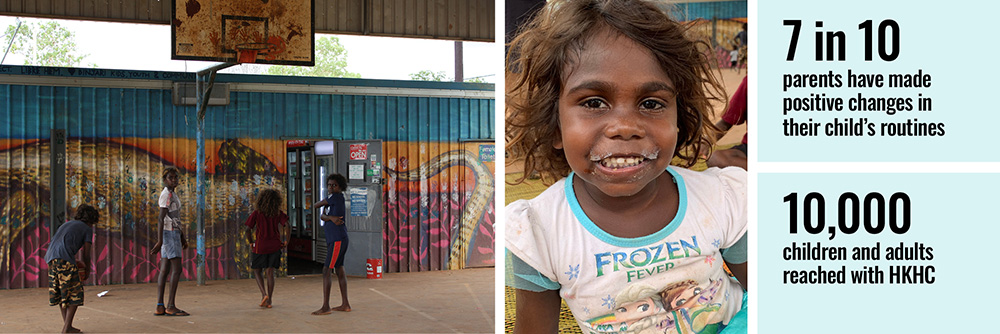 Return to top
Return to top
Healthy kids, healthy communities
Improving the health of Australian children and families

Children attending a Save the Children Play2Learn program incorporating the Healthy Kids,
Healthy Communities initiative in the Katherine Township, NT.
Photo: Emily Dienhoff/Save the Children
Healthy Kids Healthy Communities (HKHC) is a program that aims to improve the health of children and families attending our Play2Learn services by increasing the intake of nutritious foods and physical activity. HKHC has so far reached 6,328 children and 3,849 adults, primarily through our Play2Learn-supported playgroups.
Although the COVID-19 pandemic caused service delivery challenges broadly, the key messages of HKHC continued to be delivered through online and offline-adapted service delivery of Play2learn. Our staff continued to embrace HKHC as an excellent vehicle for engaging families in essential child development conversations.
Save the Children Australia commissioned an evaluation report of the HKHC program through the Murdoch Children’s Research Institute that found more than seven in ten parents reported having implemented changes in their child’s routines around: active play (79%); eating (73%); child’s screen use (72%).
In line with report recommendations, a HKHC e-learning module was co-developed with Charles Darwin University and launched in 2021 to increase staff training reach. Additionally, a six-year licensing agreement for Confident and Understanding Parents (CUPs) was entered to ensure ongoing, effective implementation of the HKHC program.
 Return to top
Return to top
Responding to the spike in family violence
Strengthening the safety and wellbeing of children and families
COVID-19 forced many women and children to be locked down in unsafe homes and during 2021, more than ever, there was an increased need for domestic and family violence refuge. With rising rental prices and extremely limited social housing; there was insufficient crisis accommodation, transitional housing and long-term housing for survivors of domestic and family violence (DFV). Those who were able to access refuge were often forced to stay longer than is preferable - with children being born and raised in refuge. No child should grow up in refuge.
In 2021, Save the Children Queensland provided 328 women and 469 children with safe refuge accommodation after they experienced a significant DFV event. 190 individuals received immediate safety support, including psychological first aid, practical necessities, referrals to other support services, and support to remain safely at home or relocate to a safe place. 69% of families exited one of our refuges into safe and sustainable housing during 2021, an incredible accomplishment amid the COVID-19 pandemic and housing crisis that affected 92% of Queenslanders.

To respond to the spike in family violence we provided women and children in need with immediate safety support, psychological first aid, practical necessities and support to relocate.
Photo: Unsplash
The gift of time
Jane* is a 38-year-old woman who escaped a violent relationship in 2016, taking her infant child with her. She was ineligible for government financial support or social housing due to her unresolved visa status. Between 2016 and 2020, Jane returned to violence on nine occasions, a continuous cycle of escaping violence and being forced back into it by paucity of choice. At the time that Jane entered one of our DFV Refuges in 2020, her 4-year-old had spent the majority of her formative years living within a series of crisis accommodation settings.
Our DFV program provides not just refuge from crisis, but a home to women like Jane. Our accommodation offers the gift of time, and a reprieve from the enormous pressure that comes from the sense that time is running out.
A mother who entered one of our Save the Children refuges said, "it enabled me to sit back for a minute and take a breath so I can start the next chapter with my kids."
Throughout this journey women and children receive ongoing, individualised support from our DFV trauma-informed specialists.
Jane and her child resided in our program throughout 2021. Jane was able to connect her with community supports and seek the medical care she had been excluded from due to affordability and ineligibility. Her child had the opportunity to form safe relationships and connect with other children of the same age.
 Return to top
Return to top